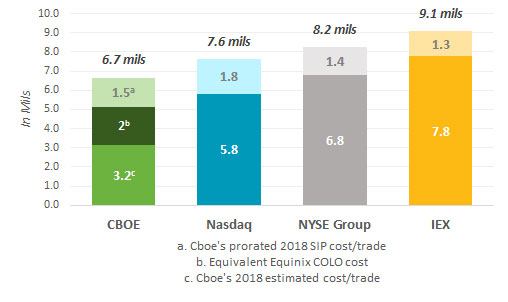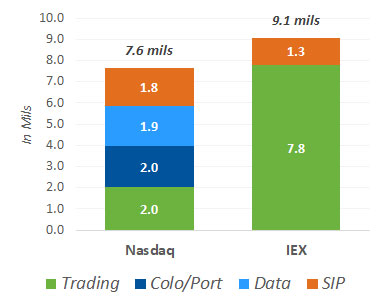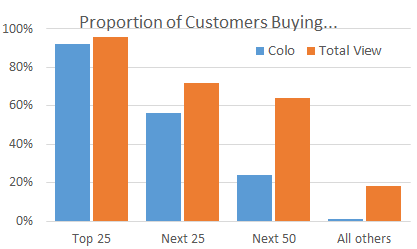It seems were all getting used to getting things for free. Cloud storage, email, social media and lots of the apps we download to our phones.
But is free good for a stock market too?
In a market with joint products, like a stock market, those who pay for other products end up subsidizing the free product-essentially they pay more than needed for the other products.
Data we have show that a user-pays marketplace is better for all participants.
Traders should care more about all-in costs to trade
Large market makers and international brokers tend to purchase a full range of products. However, even if we add the costs of colocation, data and trading per share for each of theexchanges we see that the costs, including SIP allocations, range from 0.067 to 0.091 cents per share (6.7 to 9.1 mils). That is less than 10% of the average algorithm commission of 0.9 cents per share reported byGreenwich Associates.
Chart 1: All-in costs to trade are under 10 mils (0.1 cents-per-share) across all venues

Source Nasdaq Economic Research, Nasdaq 2018 data,NYSE Insights (Nov 7, 2018), *IEX Form 1 (2017)
We also show SIP revenues allocated to each exchange (on a per-on-exchange-share basis). These are roughly equal for all exchanges. Interestingly the free data and colo model offered by IEX is the most expensive exchange on a per-share basis.
In addition, neither IEX nor CBOE host their own data center. To account for that, we have added an estimate of Equinex rent for CBOEs all in cost to trade. Although we havent done that for IEX, their customers will also need to rent data center space, in lieu of co-location, before connecting to IEX.
User-pays encourages better allocation of resources
However there are a lot of customers who only want data, or have a business offering colocation services to third parties. A user-pays business model ensures they contribute to the overall costs of trading-reducing the costs borne by those whoonlytrade (see chart 2).
Chart 2: Charging separately for data and colocation means costs are spread more fairly

Source Nasdaq Economic Research,IEX Form 1 (2017)
Data shows lots of customer choice
Looking at our data, we see lots of places where customers tailor their purchases to their needs and budgets. For example although most of our largest 25 customers (international brokers and large market makers) tend to subscribe to depth (Total View) and colocation, there are many customers who dont need these special offerings.
In fact, less than 20% of our customers buy depth, and only a fraction buy colocation.
Chart 3: Many customers use alternatives to dedicated colocation and depth data

Source Nasdaq Economic Research
We can take this analysis one step further – because many individual products can also be bought on a bulk or economy basis.
For example, connections to the exchange come in a variety of bandwidths.
All Nasdaq markets typically generate less than 1G of data per second. So for a low volume user, a 1G connection at $2,500 per month is fine. In fact even some of our top 25 customers buy these.
However when you have a lot of trading to do, you may need more bandwidth. Around two-thirds of our largest customers purchase a 10G ultra connection – which offers 10x the bandwidth for 6x the price. Importantly, very few of even our largest customers buy the premium 40G connection.
Chart 4: Many customers choose different ports to match their throughput and latency needs

Source Nasdaq Economic Research
Given the fundamental role of the market is to allocate capital efficiently, its a little bizarre that professional asset allocators think creating a free-rider problem is good for markets.
Data show that not only do customers have a lot of choice when connecting to each exchange but also when faced with the economic costs of consuming a service they actually do make choices. Thats good for everyone who doesnt want to pay for someone elses consumption. Its also good economics.




